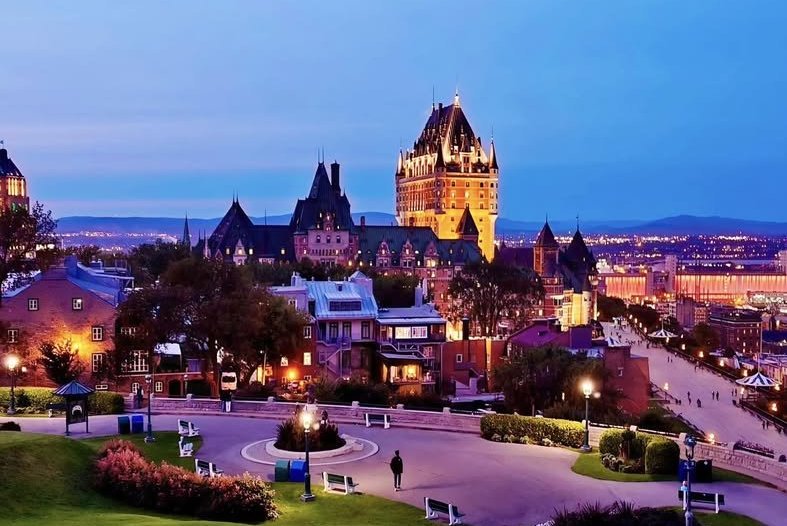
The moment I landed at Québec City’s airport, I already felt something special in the air. As I walked through the terminal, I noticed the signs around me all in French. Though I knew Québec was a French-speaking province, seeing it everywhere made me feel as if I had suddenly stepped into another continent. Québec felt so special, almost like being in Europe, with its old-world architecture, cobblestone streets, and charming cafés; it was hard to believe we were still in America. It was clear: this was not just Canada; this was Québec, a place with its own character, language, and rhythm.
I was traveling with a group of friends who shared one common obsession, K-Drama, especially the fantasy series Goblin. For them, Québec City was not just another travel destination, but a film location pilgrimage. I, on the other hand, had never watched Goblin before, so I often felt a little lost as they got overly excited about random walls or street corners. Still, I couldn’t help laughing at their enthusiasm; it was both funny and endearing to see how passionately they compared every scene from the show to the real-life places around us.
Our first stop was, of course, Old Québec, a UNESCO World Heritage Site that feels like Europe transplanted into North America. Cobblestone streets, slate roofs, and centuries-old façades greeted us at every corner. The air was crisp, and the faint sound of street musicians added to the romantic mood. For me, it was fascinating to see how history lived so vividly in the architecture, while for my friends, it was the setting of their favorite show come to life. When we reached Fairmont Le Château Frontenac, the castle-like hotel stood majestically over the St. Lawrence River, glowing under the afternoon sun. Inside, my friends were thrilled to find the shiny brass mailbox in the elevator room, another iconic prop from the drama. They took turns photographing it, just as the characters once did, their excitement echoing softly through the elegant corridors. I, meanwhile, found myself simply admiring how the hotel’s old-world charm blended perfectly with the cinematic fantasy that had brought us here.
Later, as we wandered along Rue du Petit-Champlain, I felt time slow down. The narrow street, with its colorful shops and cozy cafés, was the perfect mix of culture and charm. Near the Théâtre Petit Champlain, we finally reached the famous red back door, one of the key filming locations from Goblin. To my surprise, a long line of Asian tourists had already formed there, all eagerly waiting for their turn to recreate the iconic scene. Watching them pose in excitement, I realized how far the influence of Korean dramas had reached, connecting people from across the world in this small, picturesque corner of Québec. A little later, my friend led me to a staircase nearby without saying much, just insisting that I “had to see the view.” It turned out to be Escalier Casse-Cou, or “Breakneck Stairs,” the oldest stairway in Québec City. From there, we could look down on the charming streets below, lined with shops and hanging flowerpots. Only then did my friend tell me that this, too, was another Goblin film location. I couldn’t help but laugh, it seemed I was following the drama’s footsteps without even realizing it.
As we continued exploring, we passed through Prescott Gate, one of the remaining gateways to the fortified old town, and La Boutique de Noël de Québec, a year-round Christmas shop glowing with lights and ornaments, two more cinematic landmarks that blurred the line between history and fantasy. As the sun began to set, we ended our day at Terrasse Saint-Denis, overlooking the rooftops of Old Québec and the glimmering St. Lawrence River below. The soft golden light made the entire city look like a living painting. To my amusement, we found many groups of tourists there, once again re-enacting one of Goblin’s emotional scenes. It felt as if the boundary between fiction and reality had dissolved, leaving my friends all part of the same quiet, magical story.
By nightfall, my friends were still talking excitedly, but I was thinking about how unique Québec truly is, a place where the language, the people, and even the signs remind you that identity can be beautifully different. For me, the day wasn’t about following a story on screen; it was about discovering a city that feels timeless, where history, culture, and charm come alive in every street and corner. From the warm glow of old façades to the simple joy of a delicious crepe enjoyed on a cobblestone street, Québec’s magic lies in these little moments that make you slow down, notice the details, and savor life itself.
More on
Comments
No comments yet.
